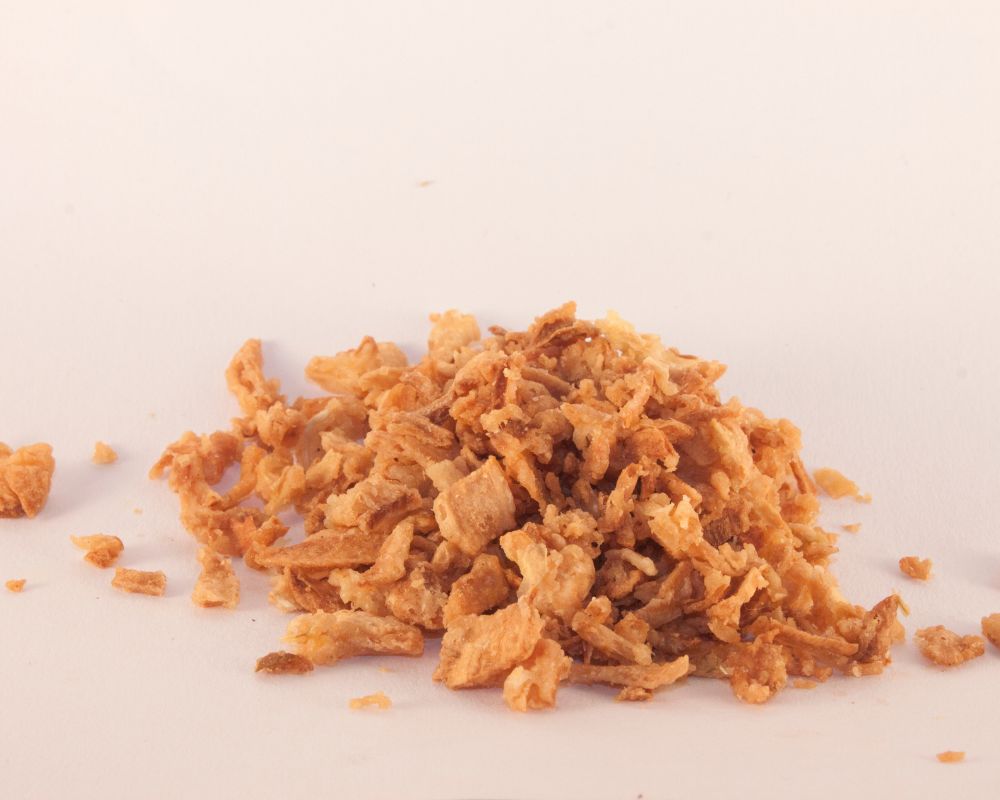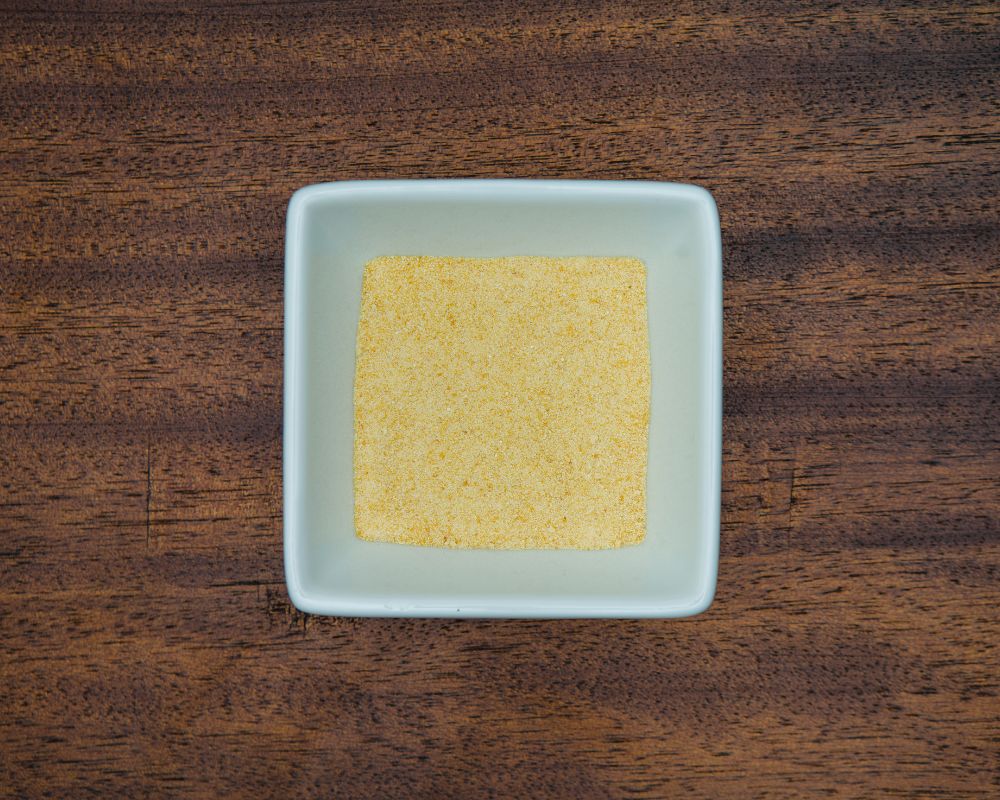Granulated onion is a type of dried onion made by slicing fresh onions and dehydrating them until all the moisture is removed. The resulting granules are light beige with a slightly crunchy texture. Regarding flavor, granulated onion is sweet and savory with a mild onion taste but less pungent than fresh onions, ideal for soups and stews.
Table of Contents
What is granulated onion?
Granulated onion is a dried, dehydrated form of onion ground into tiny granules. It is commonly used as a seasoning or flavoring agent in various cuisines.
| Origin | Uknown, used in Asia and Middle East |
| Cuisines | American, Mexican, Italian, Indian, and Cajun cuisines |
| Appearance | Fine texture, with small, uniform beige or light-yellow granules |
| Flavor profile | Sweet, a bit pungent, subtle onion flavor |
Origin
The country of origin of the granulated onion is not known. Still, onions have been cultivated and used for culinary purposes for thousands of years, dating back to ancient times in Asia and the Middle East.
Cuisines
Granulated onion is present in many dishes worldwide, including American, Mexican, Italian, Indian, and Cajun cuisines. It is a substitute for fresh onion in recipes, particularly in dishes requiring a long cooking time.
You can use granulated onions in seasoning mixes (together with granulated garlic), gravies, sauces, as a rub on any BBQ meat, and in stews and soup mixes.
Appearance
Granulated onion has a fine texture, with small, uniform beige or light-yellow granules.
Flavor profile
Granulated onion has a sweet and slightly pungent flavor, with a subtle onion taste less intense than fresh onions. It also has a slightly sweet and savory aroma that can enhance the flavor of many dishes.
Nutritional Benefits of granulated onion
Granulated onion is not only handy and tasty, but it offers several nutritional benefits. A lot of them are similar to the benefits of onion powder.
- Onions are a good source of antioxidants, essential for reducing inflammation and protecting the body against free radical damage. Dehydrated onion is no exception and can provide a concentrated dose of these compounds.
- Granulated onion is a good source of dietary fiber, vital for maintaining healthy digestion, regulating blood sugar levels, and reducing cholesterol levels.
- Granulated onion also has several vitamins and minerals, including vitamin C, B6, potassium, and folate, which are important for overall health, including immune and nerve function.
- The antioxidants and fiber in granulated onion may help reduce the risk of heart disease by lowering inflammation, reducing cholesterol levels, and improving blood pressure.
Granulated onion can have some sodium, so you should use it in moderation. Another thing to know is that people that have an onion allergy will also be allergic to the powdered or granulated version of the plant.
Comparison of granulated onion and other onion forms
There are 4 forms of onion you can use as a spice:
- Granulated onion vs. onion flakes
- Granulated onion vs. minced onion
- Granulated onion vs. onion powder
- Granulated onion vs. chopped onion
| Granulated onion | Dehydrated, fine texture |
| Onion flakes | Dehydrated, irregular shape |
| Minced onion | Dehydrated, coarse texture |
| Onion powder | Dehydrated, powdery texture |
| Chopped onion | Fresh, chopped |
1. Granulated onion vs. onion flakes


Both granulated onion and onion flakes are dehydrated forms of onion. Granulated onion is finer in texture than onion flakes, which have a larger size and irregular shape. Granulated onion dissolves more readily in liquids compared to onion flakes.
2. Granulated onion vs. minced onion


Both granulated onion and minced onion are dehydrated forms of onion. Granulated onion is finer than a minced one, which has a coarser texture and irregular shape. Granulated onion has a longer shelf life compared to a minced onion.
3. Granulated onion vs. onion powder


Both granulated onion and onion powder are dehydrated forms of onion. Granulated onion has a coarser texture than onion powder, which has a finer texture and a powdery consistency. Granulated onion has a more intense flavor compared to onion powder.
4. Granulated onion vs. chopped onion


Granulated onion is a dehydrated form of onion, while a chopped onion is a fresh onion that has been chopped. Granulated onion has a longer shelf life compared to a chopped onion. Granulated onion is more convenient than chopped onion as it can be added directly to a dish without any additional preparation.
How to use onion granules?
Here are a few ideas for using onion granules in your cooking:
- Sprinkle a generous amount over chicken, beef, or pork before cooking, or toss with potatoes, carrots, or other veggies before roasting.
- Add onion granules to soups and stews for extra flavor. They work exceptionally well in hearty soups like beef stew or chicken noodle soup.
- Mix onion granules with other spices to create your own seasoning blends. Try combining them with garlic powder, paprika, and cumin for a tasty homemade taco seasoning.
- Use onion granules to add flavor to homemade salad dressings or dips. They work well in creamy dips like ranch, onion dip, or vinaigrette salad dressings.
- Sprinkle onion granules over popcorn or potato chips for a savory snack.
Recipes with onion granules
Here are 3 great recipes that include onion in some form, where you can also use granules:
- Onion Roasted Potatoes: Toss potatoes with olive oil, onion granules, garlic powder, salt, and black pepper. Roast in the oven at 400°F for 25-30 minutes or until crispy and golden.
- Slow Cooker French Dip Sandwiches: Season beef with onion granules (instead of chopped onion), rosemary, thyme, black pepper, garlic powder, and salt, then cook in the slow cooker with beef broth and sliced onions. Serve on hoagie rolls with melted cheese and au jus for dipping.
- Creamy Onion Dip: Mix sour cream, mayonnaise, onion granules, garlic powder, and chopped fresh chives. Serve with chips, crackers, or cut vegetables for dipping.
How do you make granulated onion?
Granulated onion is made by drying and grinding fresh onions into a fine, granular powder. Here’s how you can make it at home:
- Start by selecting fresh onions. You can use various onions, but some of the best options for granulating include yellow onions, red onions, or sweet onions.
- Peel the onions and chop them into small pieces. You can use a food processor or a sharp knife to chop the onions finely. You don’t need to worry about getting perfectly uniform pieces since you will grind them into powder later.
- Spread the chopped onions out on a baking sheet in a single layer. Make sure the pieces are not touching each other, or they will take longer to dry. You can also use a dehydrator if you have one.
- Dry the onions in an oven at a low temperature, around 150-170°F, for 6-8 hours or until completely dry and brittle. You can also use a dehydrator if you have one.
- Once the onions are dry, transfer them to a food processor or blender and pulse until they turn into a fine powder. If you don’t have a food processor or blender, use a mortar and pestle to grind the dried onions into powder.
- Store the granulated onion powder in an airtight container in a cool, dry place. It should last for several months if stored properly.
You now have homemade granulated onion powder that you can use in your favorite recipes, such as soups, stews, marinades, and dry rubs. It’s a convenient way to add onion flavor to your dishes without the hassle of chopping fresh onions every time.

